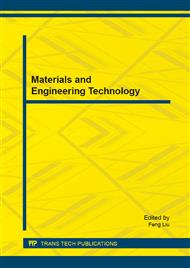[1]
Hayes, B. E., Perander, J., Smecko, T., & Trask, J. Measuring perceptions of workplace safety: Development and validation of the Workplace Safety Scale. Journal of Safety Research, 1998, 29(3), 145–161.
DOI: 10.1016/s0022-4375(98)00011-5
Google Scholar
[2]
Neal, A., Griffin, M. A., & Hart, P. M. The impact of organizational climate on safety climate and individual behavior. Safety Science, 2000, 34, 99 –109.
DOI: 10.1016/s0925-7535(00)00008-4
Google Scholar
[3]
Zohar, D. Safety climate in industrial organizations: theoretical and applied implications. The Journal Of Applied Psychology, 1980, 65(1), 96-102.
DOI: 10.1037/0021-9010.65.1.96
Google Scholar
[4]
Neal, A., & Griffin, M. A. A Study of the Lagged Relationships Among Safety Climate, Safety Motivation, Safety Behavior, and Accidents at the Individual and Group Levels. Journal of Applied Psychology, 2006, 91(4), 946-953.
DOI: 10.1037/0021-9010.91.4.946
Google Scholar
[5]
DeDobbeleer, N., and Beland, F. A safety climate measure for construction sites.,J. Safety Res. 1991, 22(2), 97–103.
DOI: 10.1016/0022-4375(91)90017-p
Google Scholar
[6]
Choudhry, R. M., Dongping, F., & Lingard, H. Measuring safety climate of a construction company. Journal of Construction Engineering & Management, 2009, 135(9), 890-899.
DOI: 10.1061/(asce)co.1943-7862.0000063
Google Scholar
[7]
Lingard, H., Cooke, T., & Blismas, N. Do perceptions of supervisors' safety responses mediate the relationship between perceptions of the organizational safety climate and incident rates in the construction supply chain?. Journal of Construction Engineering & Management, 2012, 138 (2), 234-241.
DOI: 10.1061/(asce)co.1943-7862.0000372
Google Scholar
[8]
Dongping, F., Yang, C., & Wong, L. Safety climate in construction industry: a case study in Hong Kong. Journal of Construction Engineering &Management, 2006, 132(6), 573-584.
DOI: 10.1061/(asce)0733-9364(2006)132:6(573)
Google Scholar
[9]
Koh, T., & Rowlinson, S. Relational approach in managing construction project safety: a social capital perspective. Accident Analysis & Prevention, 2012, (48)134-144.
DOI: 10.1016/j.aap.2011.03.020
Google Scholar
[10]
Nagler, M. G. Does social capital promote safety on the roads? Economic Inquiry, 2013, 51(2), 1218-1231.
DOI: 10.1111/j.1465-7295.2011.00411.x
Google Scholar
[11]
Mohnen, S. M., Völker, B., Flap, H., & Groenewegen, P. P. (). Health-related behavior as a mechanism behind the relationship between neighborhood social capital and individual health-a multilevel analysis[J]. BMC public health, 2012, 12(1), P 116.
DOI: 10.1186/1471-2458-12-116
Google Scholar
[12]
Nahapiet, J., & Ghoshal, S. Social capital intellectual capital, and the organizational advantage. Academy of Management Review, 1998, 23(2), 242-266.
DOI: 10.2307/259373
Google Scholar
[13]
Choudhry, M. R., Fang, D. P., and Mohamed, S. Developing a model of construction safety culture., J. Manage. Eng. 2007, 23(4), 207–212.
DOI: 10.1061/(asce)0742-597x(2007)23:4(207)
Google Scholar
[14]
Portes, A. Social capital: its origin and applications in modern sociology. Annual Review of Sociology, 1998, 23, 1–27.
Google Scholar
[15]
Coleman, J.S. Social capital in the creation of human capital. American Journal of Sociology 1988, 94, S95–S121.
DOI: 10.1086/228943
Google Scholar
[16]
Burt, R.S. Structural Holes: The Social Structure of Competition, Harvard University Press, Cambridge, MA. (1992).
Google Scholar
[17]
Styhre, A. The role of social capital in knowledge sharing: the case of a specialist rock construction company. Construction Management & Economics. 2008, 26(9), 941-951.
DOI: 10.1080/01446190802259035
Google Scholar
[18]
Kines, P., Andersen, L., Spangenberg, S., Mikkelsen, K., Dyreborg, J., & Zohar, D. Improving construction site safety through leader-based verbal safety communication. Journal Of Safety Research, 2010, 41(5), 399-406.
DOI: 10.1016/j.jsr.2010.06.005
Google Scholar
[19]
Reagans, R., McEvily, B. Network structure and knowledge transfer: the effects of cohesion and range. Administrative Science Quarterly, 2003, 48(2), 240-267.
DOI: 10.2307/3556658
Google Scholar
[20]
Carmeli A, Brueller D, Dutton J E. Learning behaviours in the workplace: The role of high quality interpersonal relationships and psychological safety[J]. Systems Research and Behavioral Science, 2009, 6(1). P81-98.
DOI: 10.1002/sres.932
Google Scholar


